

Marzano's High Yield Instructional Strategies. Strategies for Effective Lesson Planning. Stiliana Milkova Center for Research on Learning and Teaching A lesson plan is the instructor’s road map of what students need to learn and how it will be done effectively during the class time. Before you plan your lesson, you will first need to identify the learning objectives for the class meeting. Then, you can design appropriate learning activities and develop strategies to obtain feedback on student learning. A successful lesson plan addresses and integrates these three key components: Metacognitive Strategies or “Thinking About My Thinking” - LD@school. Add to favorites Summarized by Cindy Perras, M.Ed., OCT Educational Consultant, LDAO "Efficient learners use metacognitive strategies but students with learning disabilities tend to lack the skills to direct their own learning.
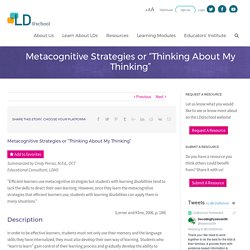
However, once they learn the metacognitive strategies that efficient learners use, students with learning disabilities can apply them in many situations.” (Lerner and Kline, 2006, p. 184) Description. Metacognitive Study Strategies for College Students. Introduction Learning is something that everyone is expected to be able to do; but very rarely does anyone sit us down and tell us how to learn.

We may learn component skills that allow us to perform a task; for example, learning specific steps to perform a task or the parts of a paragraph or essay. These are steps toward producing a product; not actually learning and mastering knowledge. Perhaps even more importantly; how do we decide what we need to learn and understand when and how we have learned it? How often, when faced with a new idea or a problem, do you sit down and think "What do I already know about this? " This course has been designed with the new college student or at-risk college student in mind, with the goal of providing skills and strategies necessary for success both in college and on the job.
Can Students Learn to Learn? Kolb’s Learning Cycle – Live Language Learning. All teachers, regardless of the discipline, must be considerate of the various learning styles of students.
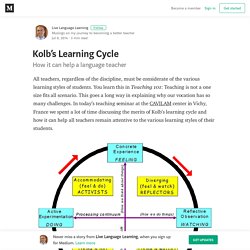
You learn this in Teaching 101: Teaching is not a one size fits all scenario. This goes a long way in explaining why our vocation has so many challenges. In today’s teaching seminar at the CAVILAM center in Vichy, France we spent a lot of time discussing the merits of Kolb’s learning cycle and how it can help all teachers remain attentive to the various learning styles of their students. We are each wired differently and have unique ways of engaging in the learning process. There is no ONE right way to learn for everyone. First, a teacher must help a student complete the full cycle of learning. The second task, which is associated with the first, is that teachers need to vary their activities so that no one style of learning is favored over the others. Kolb Learning Cycle Tutorial - Static Version. Text and concept by Clara Davies (SDDU, University of Leeds) Tutorial design by Tony Lowe (LDU, UNversity of Leeds) Multimedia version (Flash plug-in required).
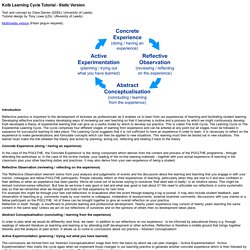
Introduction Reflective practice is important to the development of lecturers as professionals as it enables us to learn from our experiences of teaching and facilitating student learning. Developing reflective practice means developing ways of reviewing our own teaching so that it becomes a routine and a process by which we might continuously develop. Kolb developed a theory of experiential learning that can give us a useful model by which to develop our practice. Concrete Experience (doing / having an experience) Reflective Observation (reviewing / reflecting on the experience) The 'Reflective Observation' element stems from your analysis and judgements of events and the discussion about the learning and teaching that you engage in with your mentor, colleagues and fellow PGCLTHE participants. References. Goals, Objectives and Outcomes › Assessment Primer › Assessment › University of Connecticut. Outcomes Pyramid The assessment literature is full of terminology such as “mission”, “goals”, “objectives”, “outcomes”, etc. but lacking in a consensus on a precise meaning of each of these terms.

Part of the difficulty stems from changes in approaches to education – shifts from objective-based, to competency-based, to outcomes-based, etc. education have taken place over the years with various champions of each espousing the benefits of using a different point of view. The Outcomes Pyramid shown below presents a pictorial clarification of the hierarchical relationships among several different kinds of goals, objectives, and outcomes that appear in assessment literature.
The 'pyramid' image is chosen to convey the fact that increasing complexity and level of specificity are encountered as one moves downward. The pyramid structure also reinforces the notion that learning flows from the mission of the institution down to the units of instruction. Outcomes Pyramid Definitions. Goals, Objectives and Outcomes › Assessment Primer › Assessment › University of Connecticut. Goals, Objectives and Outcomes › Assessment Primer › Assessment › University of Connecticut. Writing SMART Goals. EffectiveUseofLearningObjectives. Active Learning For The College Classroom. The past decade has seen an explosion of interest among college faculty in the teaching methods variously grouped under the terms 'active learning' and 'cooperative learning'.
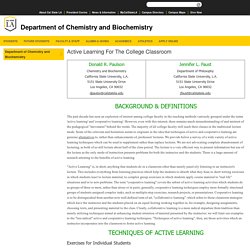
However, even with this interest, there remains much misunderstanding of and mistrust of the pedagogical "movement" behind the words. The majority of all college faculty still teach their classes in the traditional lecture mode. Learning Outcomes. Most often we view results as the final outcome of an intervention that can easily be measured, such as reduced costs, customer satisfaction, improved quality, etc.

However, often the results are going to be internal to the targeted individuals. Bloom’s Taxonomy. Background Information | The Original Taxonomy | The Revised Taxonomy | Why Use Bloom’s Taxonomy? | Further Information The above graphic is released under a Creative Commons Attribution license. You’re free to share, reproduce, or otherwise use it, as long as you attribute it to the Vanderbilt University Center for Teaching. For a higher resolution version, visit our Flickr account and look for the “Download this photo” icon. Bloom's Taxonomy of Learning Domains: The Cognitive Domain.
Bloom's Taxonomy was created in 1956 under the leadership of educational psychologist Dr Benjamin Bloom in order to promote higher forms of thinking in education, such as analyzing and evaluating concepts, processes, procedures, and principles, rather than just remembering facts (rote learning).
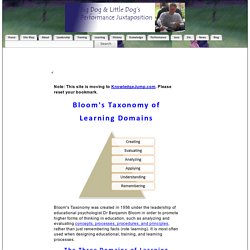
It is most often used when designing educational, training, and learning processes. The Three Domains of Learning The committee identified three domains of educational activities or learning (Bloom, et al. 1956): Cognitive: mental skills (knowledge) Affective: growth in feelings or emotional areas (attitude or self) Psychomotor: manual or physical skills (skills)
Time. In the average week, how much time to you spend preparing to teach all of your courses (reading, finding/uploading content, updating Moodle, planning lessons, assignments, or assessments)? Objectives. Trois outils d'aide à l'enseignement de l'anglais - 50 Blended Learning Resources For Teachers [Updated For 2019]